人教版(2019)选择性必修 第二册Unit 5 First Aid Discovering Useful Structures—Review of the -ing form 课件(共38张PPT
文档属性
| 名称 | 人教版(2019)选择性必修 第二册Unit 5 First Aid Discovering Useful Structures—Review of the -ing form 课件(共38张PPT |  | |
| 格式 | pptx | ||
| 文件大小 | 739.9KB | ||
| 资源类型 | 教案 | ||
| 版本资源 | 人教版(2019) | ||
| 科目 | 英语 | ||
| 更新时间 | 2024-04-05 21:24:06 | ||
图片预览


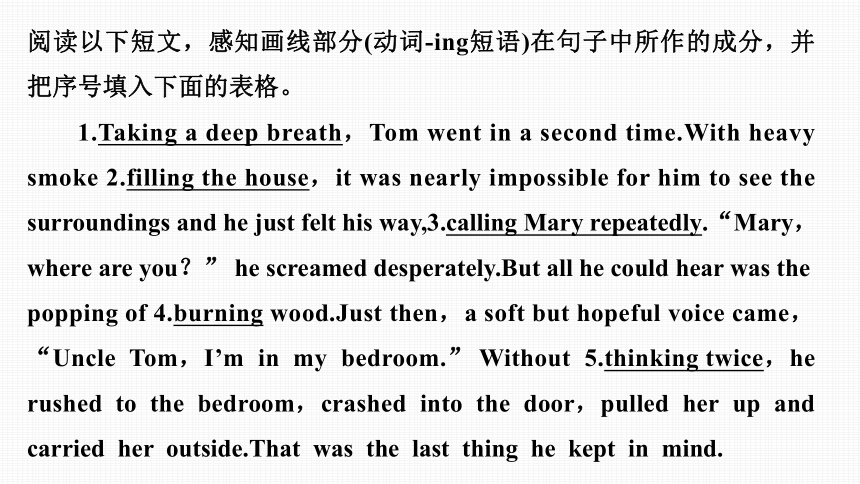
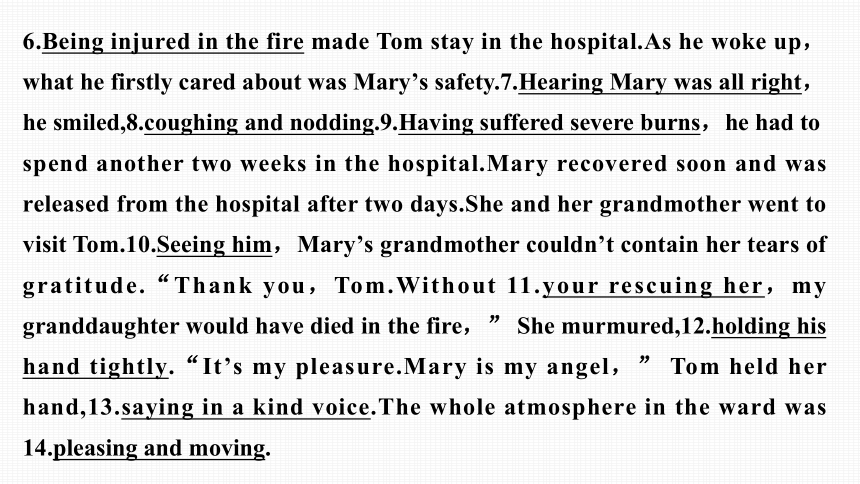
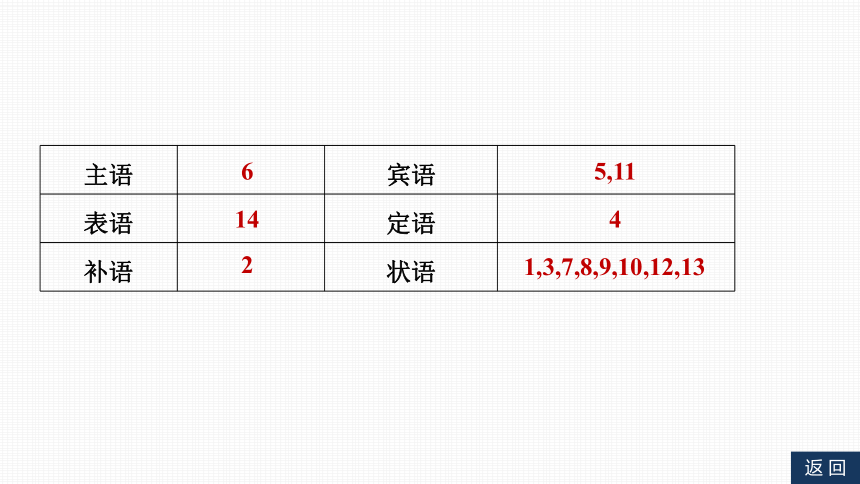

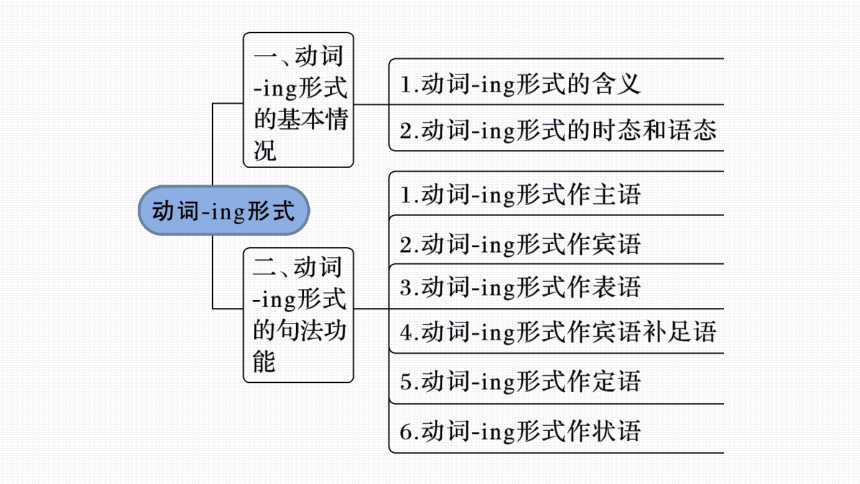
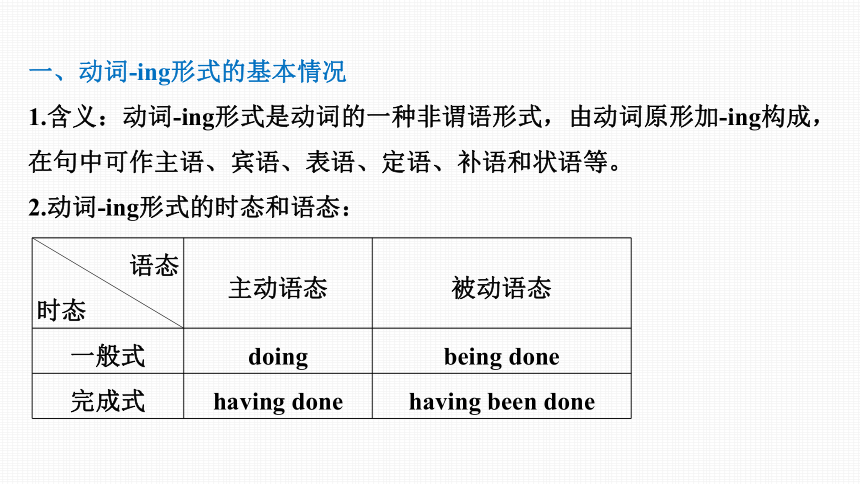
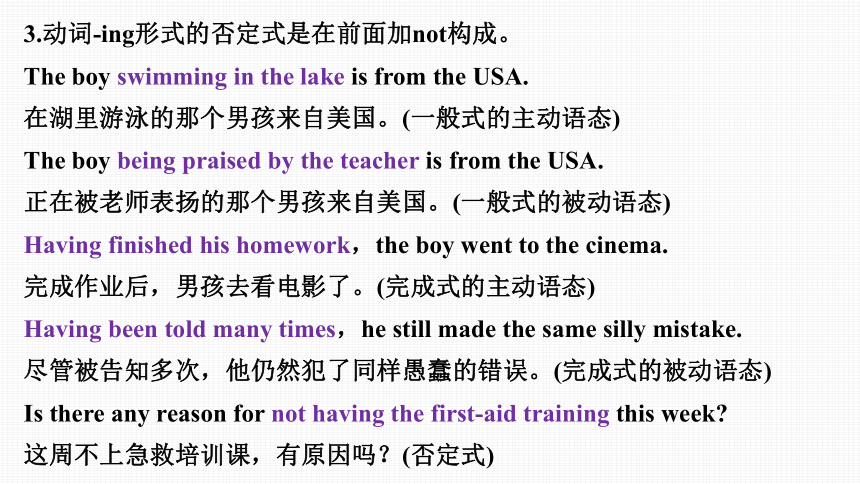
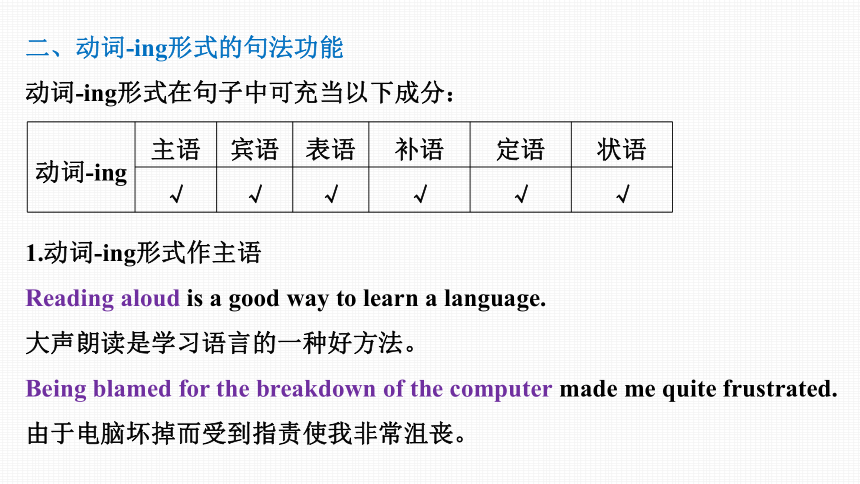

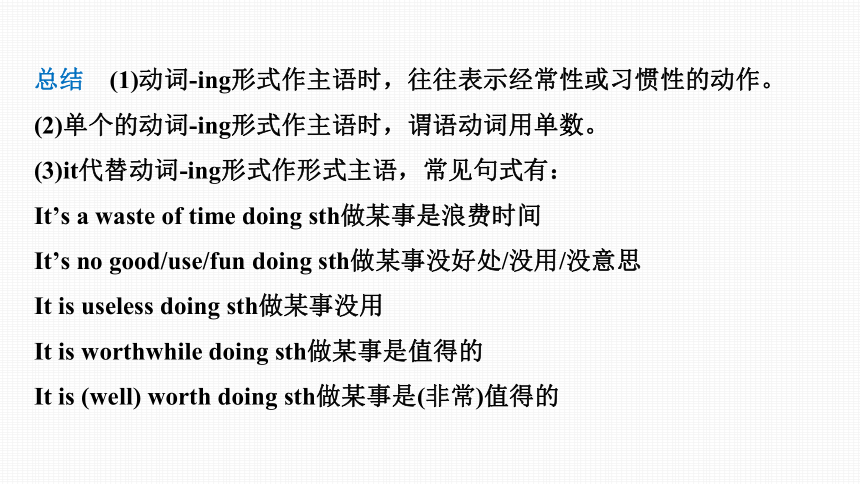
文档简介
(共38张PPT)
Discovering Useful Structures—Review of the -ing form
Unit 5
First aid
语境 感悟
阅读以下短文,感知画线部分(动词-ing短语)在句子中所作的成分,并把序号填入下面的表格。
1.Taking a deep breath,Tom went in a second time.With heavy smoke 2.filling the house,it was nearly impossible for him to see the surroundings and he just felt his way,3.calling Mary repeatedly.“Mary,where are you?” he screamed desperately.But all he could hear was the popping of 4.burning wood.Just then,a soft but hopeful voice came,“Uncle Tom,I’m in my bedroom.” Without 5.thinking twice,he rushed to the bedroom,crashed into the door,pulled her up and carried her outside.That was the last thing he kept in mind.
6.Being injured in the fire made Tom stay in the hospital.As he woke up,what he firstly cared about was Mary’s safety.7.Hearing Mary was all right,he smiled,8.coughing and nodding.9.Having suffered severe burns,he had to spend another two weeks in the hospital.Mary recovered soon and was released from the hospital after two days.She and her grandmother went to visit Tom.10.Seeing him,Mary’s grandmother couldn’t contain her tears of gratitude.“Thank you,Tom.Without 11.your rescuing her,my granddaughter would have died in the fire,” She murmured,12.holding his hand tightly.“It’s my pleasure.Mary is my angel,” Tom held her hand,13.saying in a kind voice.The whole atmosphere in the ward was 14.pleasing and moving.
主语 宾语
表语 定语
补语 状语
6
5,11
14
4
2
1,3,7,8,9,10,12,13
返 回
语法 精讲
一、动词-ing形式的基本情况
1.含义:动词-ing形式是动词的一种非谓语形式,由动词原形加-ing构成,在句中可作主语、宾语、表语、定语、补语和状语等。
2.动词-ing形式的时态和语态:
语态 时态 主动语态 被动语态
一般式 doing being done
完成式 having done having been done
3.动词-ing形式的否定式是在前面加not构成。
The boy swimming in the lake is from the USA.
在湖里游泳的那个男孩来自美国。(一般式的主动语态)
The boy being praised by the teacher is from the USA.
正在被老师表扬的那个男孩来自美国。(一般式的被动语态)
Having finished his homework,the boy went to the cinema.
完成作业后,男孩去看电影了。(完成式的主动语态)
Having been told many times,he still made the same silly mistake.
尽管被告知多次,他仍然犯了同样愚蠢的错误。(完成式的被动语态)
Is there any reason for not having the first-aid training this week
这周不上急救培训课,有原因吗?(否定式)
二、动词-ing形式的句法功能
动词-ing形式在句子中可充当以下成分:
动词-ing 主语 宾语 表语 补语 定语 状语
√ √ √ √ √ √
1.动词-ing形式作主语
Reading aloud is a good way to learn a language.
大声朗读是学习语言的一种好方法。
Being blamed for the breakdown of the computer made me quite frustrated.
由于电脑坏掉而受到指责使我非常沮丧。
Being liked creates opportunities for learning and for new kinds of life experiences.
被他人喜欢能创造学习和新的生活体验的机会。
It is no use waiting for other people to make decisions for you.
等别人替你做决定是没用的。
总结 (1)动词-ing形式作主语时,往往表示经常性或习惯性的动作。
(2)单个的动词-ing形式作主语时,谓语动词用单数。
(3)it代替动词-ing形式作形式主语,常见句式有:
It’s a waste of time doing sth做某事是浪费时间
It’s no good/use/fun doing sth做某事没好处/没用/没意思
It is useless doing sth做某事没用
It is worthwhile doing sth做某事是值得的
It is (well) worth doing sth做某事是(非常)值得的
2.动词-ing形式作宾语
(1)作动词的宾语
Would you mind opening the window
你介意打开窗子吗?
I don’t like watching television but I enjoy listening to the radio.
我不喜欢看电视,但是喜欢听广播。
He narrowly avoided being killed in the accident.
在这次事故中他九死一生。
总结 常接动词-ing形式作宾语的动词可用下面的口诀帮助记忆:
避免错过少延期(avoid,miss,postpone)
建议完成多练习(advise/suggest,finish,practise)
喜欢想象禁不住(enjoy,imagine,can’t help)
承认否定与嫉妒(admit,deny,envy)
逃避冒险莫原谅(escape,risk,excuse)
忍受保持不介意(stand,keep,mind)
(2)作介词的宾语
He insisted on doing it in his own way.
他坚持要按照自己的方法做。
I am looking forward to being admitted to a key university.我盼望着被一所重点大学录取。
总结 常接动词-ing形式作宾语的动词短语有:insist on(坚持),object to(反对),lead to(导致),put off(推迟),give up(放弃),look forward to(盼望),feel like(想要),devote...to(致力于),get used to(习惯于),pay attention to(注意)等。
(3)有些动词(短语)后跟不定式和动词-ing形式作宾语均可,但含义不同。
Please remember to give my best regards to your family.
请记着给你的家人送上我最好的祝福。
I still remember visiting the museum for the first time.
我仍记得第一次参观博物馆的情景。
Don’t forget to post the letter on your way to school.
别忘了在上学的路上顺便把这封信寄出去。
I shall never forget hearing her singing the song.
我将永远都不会忘记听她唱这首歌时的情景。
总结 有这样用法的动词(短语)见下表:
动词 宾语的形式 意义
forget to do 忘记要去做……
doing 忘记做过……
remember to do 记着要去做……
doing 记得做过……
regret to do 遗憾/抱歉要做……
doing 后悔做了……
try to do 尽力做……
doing 尝试做……
mean to do 打算做……
doing 意味着……
go on to do 接着做(另一件事)
doing 接着做(同一件事)
stop to do 停下来去做(另一件事)
doing 停止做(正在做的事)
(4)在有些动词的后面,如:start,begin,continue等既可接动名词也可接不定式作宾语,两者意义区别不大。
They continued working/to work as if nothing had happened.
他们继续工作,好像什么也没发生过似的。
(5)动词-ing的主动形式表被动
The bike needs repairing.=The bike needs to be repaired.
这辆自行车需要修理。
His behavior deserves praising.= His behavior deserves to be praised.
他的行为值得表扬。
The book is well worth reading.这本书非常值得一读。
总结 动词-ing形式的主动形式表示被动意义,相当于不定式的被动形式。常见的有:
need/want/require doing sth=need/want/require to be done sth需要做某事
deserve doing sth=deserve to be done sth值得做某事
be well worth doing sth非常值得做某事
(6)在以下结构中,动词-ing形式作介词的宾语,介词常省略。
spend...(in) doing sth花费……做某事
have difficulty/trouble (in) doing...做……有困难/麻烦
stop/prevent...(from) doing sth阻止……做某事
waste time (in) doing sth浪费时间做某事
be busy (in) doing sth忙于做某事
have a good/hard time (in) doing sth做某事很愉快/费了很大劲做某事
There is no point/sense (in) doing sth做某事毫无意义
3.动词-ing形式作表语
The argument is very convincing.
这个论点很令人信服。
Your speech is very interesting and encouraging.
你的演讲很有趣而且很鼓舞人心。
Her job is keeping the lecture hall as clean as possible.
她的工作是尽量使报告厅保持干净。
总结 动词-ing形式作表语说明主语的性质、特征或具体内容。常见的有:moving,interesting,encouraging,exciting,inspiring,boring,surprising,puzzling,amusing,astonishing等。
4.动词-ing形式作宾语补足语
动词-ing形式作宾语补足语时,表示正在进行的动作或经常存在的状态。
(1)感官动词(短语)
I felt somebody standing behind me.
我感觉有人站在我后面。
I saw the little boy crying there.
我看到那个小男孩正在那儿哭。
总结 常见的感官动词(短语)有:see,hear,feel,smell,find,notice,observe,look at,listen to。常用结构为“感官动词+宾语+宾补”。
(2)使役动词
We kept the fire burning all night long.
我们让火整夜燃烧着。
I won’t have you running about in the room.
我不允许你在房间里跑来跑去。
I won’t let you lie to others.
我不会让你对别人撒谎。
Online shopping can get you to be addicted to it.
网上购物使你对其上瘾。
总结 使役动词的常见结构有:have/keep/get/leave sb/sth+doing sth使……一直做某事
have/let/make sb+do sth=get/cause sb to do sth使/让某人做某事
(3)with复合结构
With so many people looking at her,she felt nervous.这么多人看着她,她感到紧张。
With my proposal declined,I was in low spirits.
由于我的提议被拒绝,我情绪很低落。
With so much work to do,he was nearly in despair.
有如此多的工作要做,他几乎绝望了。
总结 with的复合结构的常见用法如下:with+宾语+doing(表示主动或进行)
with+宾语+done(表示被动或完成)
with+宾语+to do(表示将来)
5.动词-ing形式作定语
(1)前置定语(放在所修饰的名词前)
In summer I often swim in the swimming pool.(表示用途)
夏天我经常在游泳池游泳。
Do you know the swimming boy?(表示正在进行的动作)
你认识这个正在游泳的男孩吗?
总结 动词-ing形式作前置定语表示被修饰词的某种用途或者正在进行的动作。
(2)后置定语(放在所修饰的名词后)
The boy playing football on the playground is my younger brother.
=The boy that/who is playing football on the playground is my younger brother.
正在操场上踢足球的那个男孩是我的弟弟。
There is much evidence showing that music activities engage different parts of the brain.
=There is much evidence which/that shows that music activities engage different parts of the brain.
有许多证据表明音乐活动占用大脑的不同部分。
The meeting being held now is of great significance.
=The meeting which/that is being held now is of great significance.
现在举行的会议非常重要。
总结 动词-ing形式作后置定语时,表示被修饰词所进行的动作,相当于一个定语从句。
6.动词-ing形式作状语
When/While she was walking in the park,she saw an old friend.
=When/While walking in the park,she saw an old friend.
=Walking in the park,she saw an old friend.(时间状语)
她在公园里散步时,看到了一位老朋友。
As he was ill,he couldn’t go to school.
=Being ill,he couldn’t go to school.(原因状语)
因为生病了,他不能去上学。
If you work hard,you’ll make great progress.
=Working hard,you’ll make great progress.(条件状语)
如果你努力工作,你将取得很大进步。
Mary sat by the window of the classroom and was reading a book.
=Mary sat by the window of the classroom,reading a book.(伴随状语)
玛丽坐在教室的窗边,读着一本书。
Though they knew all this,they made me pay for the damage.
=Though knowing all this,they made me pay for the damage.(让步状语)
尽管他们了解这一切,但还是让我赔偿损失。
The hospital has recently obtained new medical equipment,allowing more patients to be treated.(意料之中的结果状语)
这家医院最近得到一批新的医疗设备,这使更多的病人能得到治疗。
We Chinese eat with chopsticks.
=We Chinese eat using chopsticks.(方式状语)
我们中国人用筷子吃饭。
总结 动词-ing形式在句中作状语来修饰谓语动词或整个句子,表示动作发生的时间、原因、条件、结果、方式、让步或伴随状况,为表意更明确可在其前加上相应的连词,如when,while,though等。
注意:
1.当动词-ing形式的动作先发生,而谓语动词的动作后发生时,用having done/having been done作状语。
Having finished the letter,he went to post it.
他写完信后就把它寄了出去。(having finished是先发生的,went是后发生的)
Having been told many times,he couldn’t understand what I meant.
尽管已被告知多次,但他不能理解我的意思。
2.动名词的复合结构
Tom’s/His coming home late worries his mother.
汤姆/他回家晚使他妈妈担心。
I remember Tom’s/Tom going there.
我记得汤姆去过那里。
I remember his/him being awarded a prize.
我记得他获奖了。
总结 动名词的复合结构在句中主要作主语或宾语。
作主语时的形式:所有格/形容词性物主代词+doing;
作宾语时的形式:所有格/形容词性物主代词/代词宾格/名词+doing。
返 回
达标检测
(2021·浙江1月,读后续写)——头卡在大南瓜里
我的头卡在大南瓜里,我非常害怕,我的喉咙发紧,膝盖发软。南瓜里的空气充满了我焦虑的呼吸。如果不是太好奇,我就不会陷于如此令人尴尬的窘境了。看到我的尴尬,我爸爸咧嘴笑了。最终他成功地把我的头从南瓜里拔了出来。使我生气的是,我妈妈录制了我的窘境。
完成下列语段,尽可能多地使用动词-ing形式
,I was frightened,____
.The air in the pumpkin was full of my anxious breath. ,I wouldn’t have been caught in . ,
my dad grinned from ear to ear.Finally he succeeded in _______________
.Then, really made me angry.
返 回
With my head stuck in the huge pumpkin
with
my throat tightening and my knees feeling weak
Without being so curious
such an embarrassing dilemma
Seeing the embarrassment
pulling my head
out of it
my mom’s recording my dilemma
Discovering Useful Structures—Review of the -ing form
Unit 5
First aid
语境 感悟
阅读以下短文,感知画线部分(动词-ing短语)在句子中所作的成分,并把序号填入下面的表格。
1.Taking a deep breath,Tom went in a second time.With heavy smoke 2.filling the house,it was nearly impossible for him to see the surroundings and he just felt his way,3.calling Mary repeatedly.“Mary,where are you?” he screamed desperately.But all he could hear was the popping of 4.burning wood.Just then,a soft but hopeful voice came,“Uncle Tom,I’m in my bedroom.” Without 5.thinking twice,he rushed to the bedroom,crashed into the door,pulled her up and carried her outside.That was the last thing he kept in mind.
6.Being injured in the fire made Tom stay in the hospital.As he woke up,what he firstly cared about was Mary’s safety.7.Hearing Mary was all right,he smiled,8.coughing and nodding.9.Having suffered severe burns,he had to spend another two weeks in the hospital.Mary recovered soon and was released from the hospital after two days.She and her grandmother went to visit Tom.10.Seeing him,Mary’s grandmother couldn’t contain her tears of gratitude.“Thank you,Tom.Without 11.your rescuing her,my granddaughter would have died in the fire,” She murmured,12.holding his hand tightly.“It’s my pleasure.Mary is my angel,” Tom held her hand,13.saying in a kind voice.The whole atmosphere in the ward was 14.pleasing and moving.
主语 宾语
表语 定语
补语 状语
6
5,11
14
4
2
1,3,7,8,9,10,12,13
返 回
语法 精讲
一、动词-ing形式的基本情况
1.含义:动词-ing形式是动词的一种非谓语形式,由动词原形加-ing构成,在句中可作主语、宾语、表语、定语、补语和状语等。
2.动词-ing形式的时态和语态:
语态 时态 主动语态 被动语态
一般式 doing being done
完成式 having done having been done
3.动词-ing形式的否定式是在前面加not构成。
The boy swimming in the lake is from the USA.
在湖里游泳的那个男孩来自美国。(一般式的主动语态)
The boy being praised by the teacher is from the USA.
正在被老师表扬的那个男孩来自美国。(一般式的被动语态)
Having finished his homework,the boy went to the cinema.
完成作业后,男孩去看电影了。(完成式的主动语态)
Having been told many times,he still made the same silly mistake.
尽管被告知多次,他仍然犯了同样愚蠢的错误。(完成式的被动语态)
Is there any reason for not having the first-aid training this week
这周不上急救培训课,有原因吗?(否定式)
二、动词-ing形式的句法功能
动词-ing形式在句子中可充当以下成分:
动词-ing 主语 宾语 表语 补语 定语 状语
√ √ √ √ √ √
1.动词-ing形式作主语
Reading aloud is a good way to learn a language.
大声朗读是学习语言的一种好方法。
Being blamed for the breakdown of the computer made me quite frustrated.
由于电脑坏掉而受到指责使我非常沮丧。
Being liked creates opportunities for learning and for new kinds of life experiences.
被他人喜欢能创造学习和新的生活体验的机会。
It is no use waiting for other people to make decisions for you.
等别人替你做决定是没用的。
总结 (1)动词-ing形式作主语时,往往表示经常性或习惯性的动作。
(2)单个的动词-ing形式作主语时,谓语动词用单数。
(3)it代替动词-ing形式作形式主语,常见句式有:
It’s a waste of time doing sth做某事是浪费时间
It’s no good/use/fun doing sth做某事没好处/没用/没意思
It is useless doing sth做某事没用
It is worthwhile doing sth做某事是值得的
It is (well) worth doing sth做某事是(非常)值得的
2.动词-ing形式作宾语
(1)作动词的宾语
Would you mind opening the window
你介意打开窗子吗?
I don’t like watching television but I enjoy listening to the radio.
我不喜欢看电视,但是喜欢听广播。
He narrowly avoided being killed in the accident.
在这次事故中他九死一生。
总结 常接动词-ing形式作宾语的动词可用下面的口诀帮助记忆:
避免错过少延期(avoid,miss,postpone)
建议完成多练习(advise/suggest,finish,practise)
喜欢想象禁不住(enjoy,imagine,can’t help)
承认否定与嫉妒(admit,deny,envy)
逃避冒险莫原谅(escape,risk,excuse)
忍受保持不介意(stand,keep,mind)
(2)作介词的宾语
He insisted on doing it in his own way.
他坚持要按照自己的方法做。
I am looking forward to being admitted to a key university.我盼望着被一所重点大学录取。
总结 常接动词-ing形式作宾语的动词短语有:insist on(坚持),object to(反对),lead to(导致),put off(推迟),give up(放弃),look forward to(盼望),feel like(想要),devote...to(致力于),get used to(习惯于),pay attention to(注意)等。
(3)有些动词(短语)后跟不定式和动词-ing形式作宾语均可,但含义不同。
Please remember to give my best regards to your family.
请记着给你的家人送上我最好的祝福。
I still remember visiting the museum for the first time.
我仍记得第一次参观博物馆的情景。
Don’t forget to post the letter on your way to school.
别忘了在上学的路上顺便把这封信寄出去。
I shall never forget hearing her singing the song.
我将永远都不会忘记听她唱这首歌时的情景。
总结 有这样用法的动词(短语)见下表:
动词 宾语的形式 意义
forget to do 忘记要去做……
doing 忘记做过……
remember to do 记着要去做……
doing 记得做过……
regret to do 遗憾/抱歉要做……
doing 后悔做了……
try to do 尽力做……
doing 尝试做……
mean to do 打算做……
doing 意味着……
go on to do 接着做(另一件事)
doing 接着做(同一件事)
stop to do 停下来去做(另一件事)
doing 停止做(正在做的事)
(4)在有些动词的后面,如:start,begin,continue等既可接动名词也可接不定式作宾语,两者意义区别不大。
They continued working/to work as if nothing had happened.
他们继续工作,好像什么也没发生过似的。
(5)动词-ing的主动形式表被动
The bike needs repairing.=The bike needs to be repaired.
这辆自行车需要修理。
His behavior deserves praising.= His behavior deserves to be praised.
他的行为值得表扬。
The book is well worth reading.这本书非常值得一读。
总结 动词-ing形式的主动形式表示被动意义,相当于不定式的被动形式。常见的有:
need/want/require doing sth=need/want/require to be done sth需要做某事
deserve doing sth=deserve to be done sth值得做某事
be well worth doing sth非常值得做某事
(6)在以下结构中,动词-ing形式作介词的宾语,介词常省略。
spend...(in) doing sth花费……做某事
have difficulty/trouble (in) doing...做……有困难/麻烦
stop/prevent...(from) doing sth阻止……做某事
waste time (in) doing sth浪费时间做某事
be busy (in) doing sth忙于做某事
have a good/hard time (in) doing sth做某事很愉快/费了很大劲做某事
There is no point/sense (in) doing sth做某事毫无意义
3.动词-ing形式作表语
The argument is very convincing.
这个论点很令人信服。
Your speech is very interesting and encouraging.
你的演讲很有趣而且很鼓舞人心。
Her job is keeping the lecture hall as clean as possible.
她的工作是尽量使报告厅保持干净。
总结 动词-ing形式作表语说明主语的性质、特征或具体内容。常见的有:moving,interesting,encouraging,exciting,inspiring,boring,surprising,puzzling,amusing,astonishing等。
4.动词-ing形式作宾语补足语
动词-ing形式作宾语补足语时,表示正在进行的动作或经常存在的状态。
(1)感官动词(短语)
I felt somebody standing behind me.
我感觉有人站在我后面。
I saw the little boy crying there.
我看到那个小男孩正在那儿哭。
总结 常见的感官动词(短语)有:see,hear,feel,smell,find,notice,observe,look at,listen to。常用结构为“感官动词+宾语+宾补”。
(2)使役动词
We kept the fire burning all night long.
我们让火整夜燃烧着。
I won’t have you running about in the room.
我不允许你在房间里跑来跑去。
I won’t let you lie to others.
我不会让你对别人撒谎。
Online shopping can get you to be addicted to it.
网上购物使你对其上瘾。
总结 使役动词的常见结构有:have/keep/get/leave sb/sth+doing sth使……一直做某事
have/let/make sb+do sth=get/cause sb to do sth使/让某人做某事
(3)with复合结构
With so many people looking at her,she felt nervous.这么多人看着她,她感到紧张。
With my proposal declined,I was in low spirits.
由于我的提议被拒绝,我情绪很低落。
With so much work to do,he was nearly in despair.
有如此多的工作要做,他几乎绝望了。
总结 with的复合结构的常见用法如下:with+宾语+doing(表示主动或进行)
with+宾语+done(表示被动或完成)
with+宾语+to do(表示将来)
5.动词-ing形式作定语
(1)前置定语(放在所修饰的名词前)
In summer I often swim in the swimming pool.(表示用途)
夏天我经常在游泳池游泳。
Do you know the swimming boy?(表示正在进行的动作)
你认识这个正在游泳的男孩吗?
总结 动词-ing形式作前置定语表示被修饰词的某种用途或者正在进行的动作。
(2)后置定语(放在所修饰的名词后)
The boy playing football on the playground is my younger brother.
=The boy that/who is playing football on the playground is my younger brother.
正在操场上踢足球的那个男孩是我的弟弟。
There is much evidence showing that music activities engage different parts of the brain.
=There is much evidence which/that shows that music activities engage different parts of the brain.
有许多证据表明音乐活动占用大脑的不同部分。
The meeting being held now is of great significance.
=The meeting which/that is being held now is of great significance.
现在举行的会议非常重要。
总结 动词-ing形式作后置定语时,表示被修饰词所进行的动作,相当于一个定语从句。
6.动词-ing形式作状语
When/While she was walking in the park,she saw an old friend.
=When/While walking in the park,she saw an old friend.
=Walking in the park,she saw an old friend.(时间状语)
她在公园里散步时,看到了一位老朋友。
As he was ill,he couldn’t go to school.
=Being ill,he couldn’t go to school.(原因状语)
因为生病了,他不能去上学。
If you work hard,you’ll make great progress.
=Working hard,you’ll make great progress.(条件状语)
如果你努力工作,你将取得很大进步。
Mary sat by the window of the classroom and was reading a book.
=Mary sat by the window of the classroom,reading a book.(伴随状语)
玛丽坐在教室的窗边,读着一本书。
Though they knew all this,they made me pay for the damage.
=Though knowing all this,they made me pay for the damage.(让步状语)
尽管他们了解这一切,但还是让我赔偿损失。
The hospital has recently obtained new medical equipment,allowing more patients to be treated.(意料之中的结果状语)
这家医院最近得到一批新的医疗设备,这使更多的病人能得到治疗。
We Chinese eat with chopsticks.
=We Chinese eat using chopsticks.(方式状语)
我们中国人用筷子吃饭。
总结 动词-ing形式在句中作状语来修饰谓语动词或整个句子,表示动作发生的时间、原因、条件、结果、方式、让步或伴随状况,为表意更明确可在其前加上相应的连词,如when,while,though等。
注意:
1.当动词-ing形式的动作先发生,而谓语动词的动作后发生时,用having done/having been done作状语。
Having finished the letter,he went to post it.
他写完信后就把它寄了出去。(having finished是先发生的,went是后发生的)
Having been told many times,he couldn’t understand what I meant.
尽管已被告知多次,但他不能理解我的意思。
2.动名词的复合结构
Tom’s/His coming home late worries his mother.
汤姆/他回家晚使他妈妈担心。
I remember Tom’s/Tom going there.
我记得汤姆去过那里。
I remember his/him being awarded a prize.
我记得他获奖了。
总结 动名词的复合结构在句中主要作主语或宾语。
作主语时的形式:所有格/形容词性物主代词+doing;
作宾语时的形式:所有格/形容词性物主代词/代词宾格/名词+doing。
返 回
达标检测
(2021·浙江1月,读后续写)——头卡在大南瓜里
我的头卡在大南瓜里,我非常害怕,我的喉咙发紧,膝盖发软。南瓜里的空气充满了我焦虑的呼吸。如果不是太好奇,我就不会陷于如此令人尴尬的窘境了。看到我的尴尬,我爸爸咧嘴笑了。最终他成功地把我的头从南瓜里拔了出来。使我生气的是,我妈妈录制了我的窘境。
完成下列语段,尽可能多地使用动词-ing形式
,I was frightened,____
.The air in the pumpkin was full of my anxious breath. ,I wouldn’t have been caught in . ,
my dad grinned from ear to ear.Finally he succeeded in _______________
.Then, really made me angry.
返 回
With my head stuck in the huge pumpkin
with
my throat tightening and my knees feeling weak
Without being so curious
such an embarrassing dilemma
Seeing the embarrassment
pulling my head
out of it
my mom’s recording my dilemma
